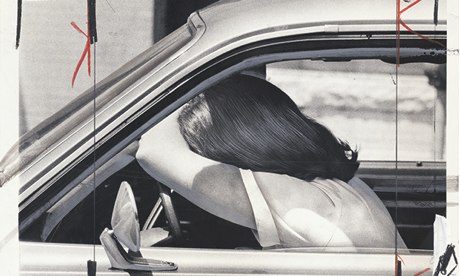Photography writer David Campany has collected some extraordinary photographs of American gas stations in a new book, Gasoline, which tells the story of our foremost liquid addiction — alcoholism pales in comparison.
From the Guardian:
“Running out of gas, Rabbit Angstrom thinks as he stands behind the summer-dusty windows of the Springer Motors display room watching the traffic go by on Route 111, traffic somehow thin and scared compared to what it used to be. The fucking world is running out of gas.” So begins John Updike’s novel Rabbit Is Rich, which is set in the 1970s, when it seemed like the world was indeed running out of gasoline.
Set against a backdrop of American unease heightened by petrol rationing and long fractious queues at gas pumps, Updike’s story illustrates how important oil is to the smooth running of things, both automotive and sociopolitical. America runs on gasoline. So does the American dream, as shown in so many stories, songs and films that hymn the open road and the fast car as the ultimate symbol of freedom.
This is one of the subtexts of Gasoline, a book of photographs of American gas stations rescued from various newspaper archives and edited into a visual meta-narrrative by the British photography writer David Campany. It’s an intriguing book, not least because its publication chimes with the 50th anniversary of one of the most iconic photobooks of all time: Ed Ruscha’s Twentysix Gasoline Stations. Ruscha commercially printed his book of wilfully anonymous photographs as an antidote to the overly precious, limited-edition, collectable artist’s book, producing a first print run of 400 and selling it for $3 a copy. As Campany notes in an interview included in Gasoline, the very “stylelessness” of Ruscha’s images has become their defining aspect. “The problem is that photographs don’t remain unspecial and styleless for long. In unforeseen ways, the passing of time renders them significant.”
So it is with these found images of gasoline stations. They are, Campany notes, “a good measure of what is going on in society”, whether that is austerity or growth, changes in car manufacture or the decline of industrial cities and the freeways that link them. The cover image is one of the most striking: a young woman slumped on the steering wheel of her car, her head resting on her forearm as if exhausted or exasperated. This is the image from which the entire project sprang. Her name is Pat Sullivan and she was photographed while waiting in line at a gasoline station in Baltimore in 1979. A press cutting on the back of the original image, also included in the book, reads: “Pat Sullivan lowers her head in despair while waiting for gas in a long line yesterday at Lafayette and Charles. The lines were long again this morning …”
Campany was struck by the beauty of the image, which like most of these photographs has been marked by the grease pen of a newspaper’s art director. “The hair and the car have been retouched almost as if the newspaper wanted her to look her best even at this low point … But that image was so evocative that I felt I wanted to place it in a story of the second half of the 20th century.” Which is just what Gasoline does. There are images of gas station attendants and customers, iconic signage from a time before global corporations became tarnished – Gulf, Shell, Esso, BP – as well as local roadside stations in all their vernacular splendour, and sites where gasoline stations are about to be built or have just been demolished. There is black humour – a neon sign that reads We Wash Foreign Cars With Imported Water – and characteristic American stoicism – another reads No Gas Happy Holidays. There are images of gas stations that have just been robbed, destroyed by hurricanes, flooded and hit by cars.
Gasoline is an observational history of post-war America that is as richly suggestive as Twentysix Gasoline Stations is blank and detached. It shows how central gasoline is to the American way of life but, as Campany notes, it could also be read as “an allegory about news photography. Or a minor history of car design, or vernacular architecture, or street graphics, or outfits worn by pump attendants. All of the above.”
Read the entire article here.
Image: Gasoline Shortage Baltimore & Maryland. 15 June 1979. Pat Sullivan, Frustrated. Photograph: Richard Childress. David Campany / Guardian.

